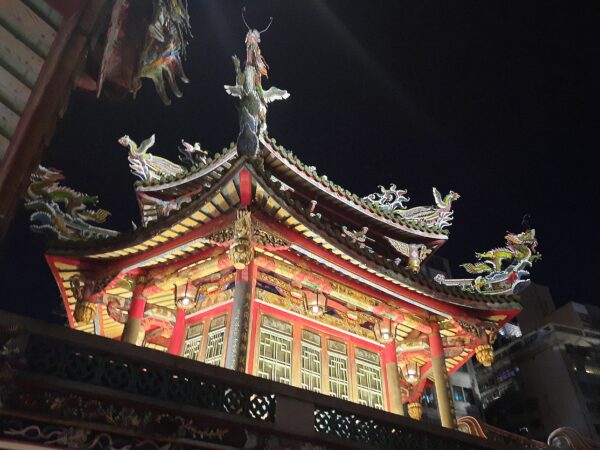Longshan Temple | Taipei’s Shrines
 Many Taiwanese say the southern city of Tainan has the island’s finest temples. They’re right — yet Taipei has ancient places of worship every visitor should make an effort to see.
Many Taiwanese say the southern city of Tainan has the island’s finest temples. They’re right — yet Taipei has ancient places of worship every visitor should make an effort to see.
The most important shrine in Wanhua (Taipei’s oldest district) is Mengjia Longshan Temple. It provides a fascinating glimpse of local religious beliefs and practices. Founded in 1738 and covering nearly 6,000 m2 (nearly one and a half acres), Longshan Temple is named after a house of worship in Fujian, the mainland Chinese province to which many Taiwanese have ancestral ties.
During the early 18th century, Chinese settlers arriving in Taiwan faced many dangers, among them bandits, contagious diseases, droughts, floods, and head-hunting indigenous people. At that time there was a local saying: ‘Of every ten people who have reached Taiwan, just three remain. Six are dead and one has returned home’.
Not surprisingly, these migrants sought the protection of the gods now worshipped in Longshan Temple, and the comfort of Buddhist doctrines related to Guanyin, a goddess of mercy. In recent years, one of the most popular deities here has been the Old Man Under the Moon (Yue Lao), a divine matchmaker. Visitors from as far away as Singapore pray to him in the hope of finding a marriage partner.
Established in the same era, yet in artistic terms even more stunning than Longshan Temple, Dalongdong Baoan Temple near the old neighbourhood of Dadaocheng is dedicated to the worship of Baosheng Dadi, a god of medicine credited with miraculous cures and defeating epidemics. The quality of the murals and carvings here received international recognition in 2003, when it was accorded an honorable mention at the UNESCO Asia-Pacific Heritage Awards. The best time to visit is springtime, when the Baosheng Cultural Festival features several weeks of firewalking, folk music, opera performances and puppet shows, as well as colourful religious parades. The festival’s precise dates are worked out by reference to the lunar calendar, and publicised well in advance.
Other important shrines in Taipei include Xingtian Temple (built in the late 1960s and dedicated to Guan Gong, who was a general in his human life but is now regarded as the god of businesspeople, police officers and gang members) and Xiahai City God Temple. The latter, located on Dihua Street, is small yet packed with effigies of the city god (to whom people make offerings hoping for prosperity and good weather), the sea goddess Mazu and the Old Man Under the Moon. Lin Chi Temple was established in 1900 to propagate Japanese Zen Buddhism. Following Japan’s defeat in World War II, the land and buildings were seized by the authorities and used for various purposes until the 1990s, when restoration work was begun. It now displays several Japanese-style features seldom seen in Taiwanese halls of worship.
